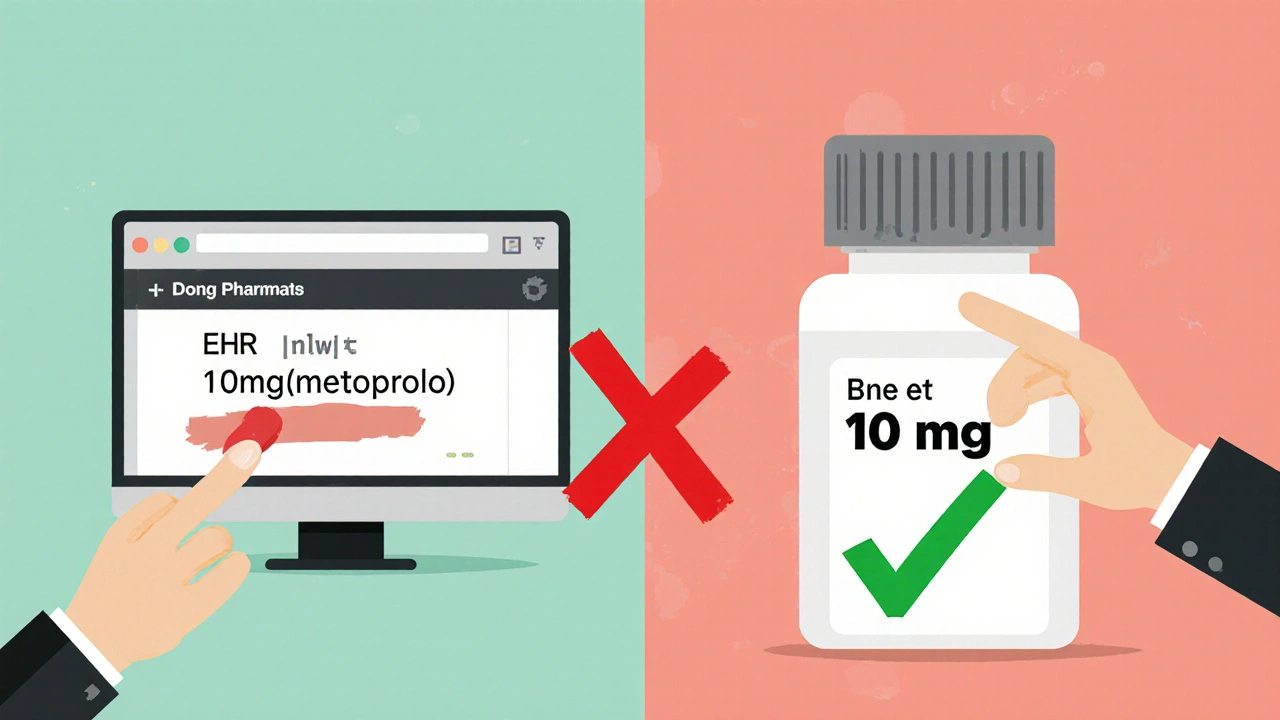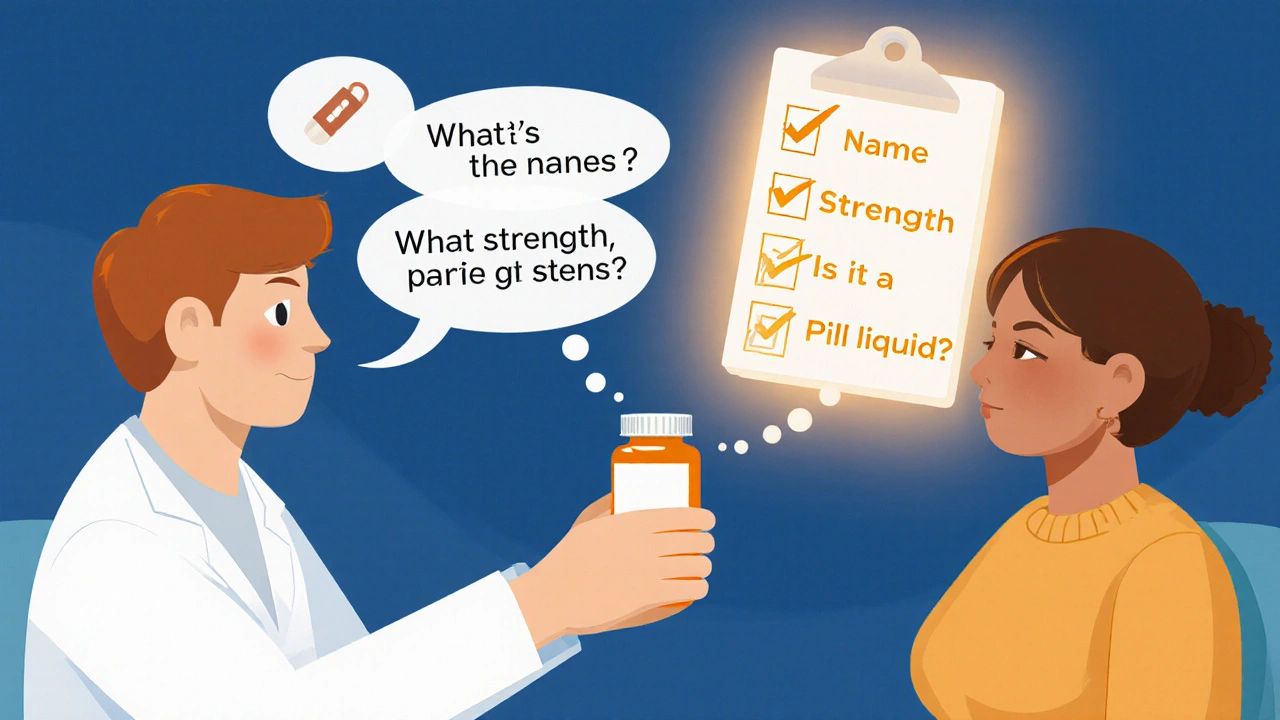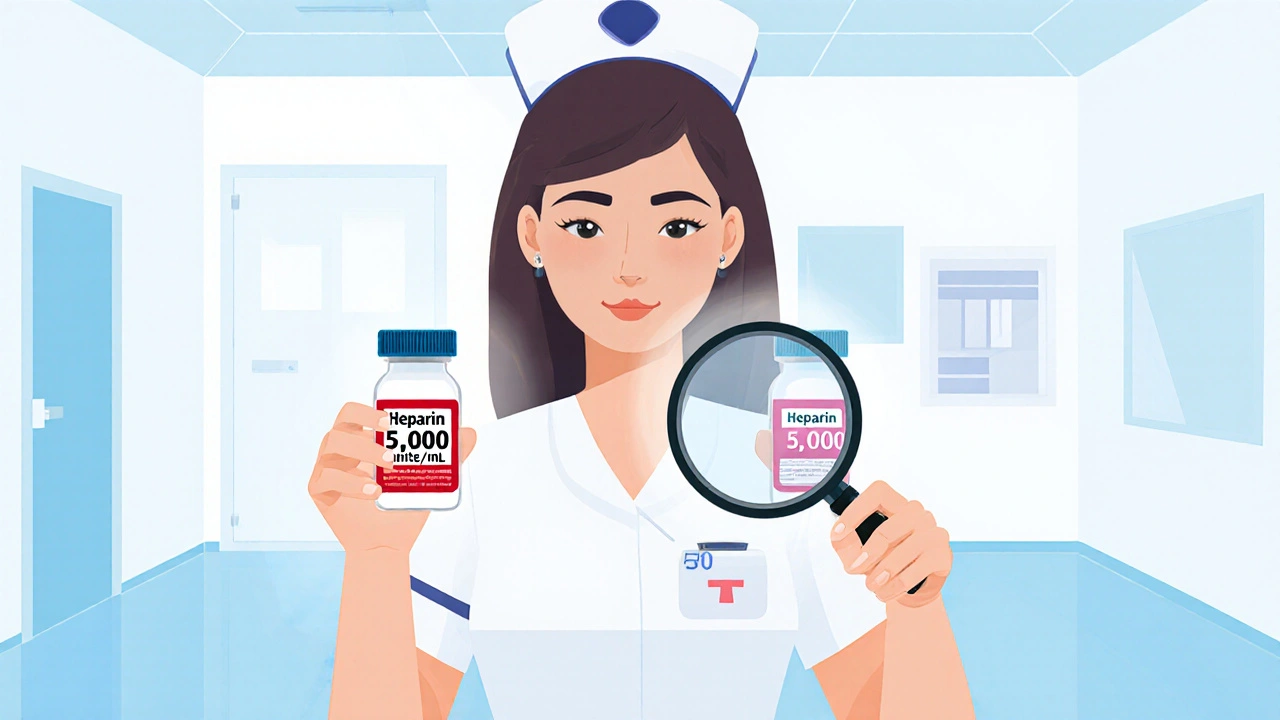Every year, over 1.5 million people in the U.S. suffer preventable harm from medication errors. Many of these mistakes happen because someone didn’t double-check the medication name, the strength, or the dosage form before giving or taking a drug. It’s not always a doctor’s mistake or a pharmacist’s slip-up. Sometimes, it’s just a quick glance at a label, a misread abbreviation, or a confusing similarity between two drugs. But the consequences can be deadly.
Why Checking Medication Details Isn’t Optional
Think about this: insulin comes in multiple strengths-U-100, U-500, and others. If you confuse them, you could give someone 500 units instead of 100. That’s a fivefold overdose. One nurse in Texas saved a patient’s life just by reading the vial label out loud before injecting. The order said "Heparin 5,000 units/mL," but the vial said "50 units/mL." She caught it. She didn’t assume. She checked. The Institute of Medicine found that medication errors cause at least 7,000 deaths a year in U.S. hospitals alone. The Agency for Healthcare Research and Quality says most of these aren’t caused by carelessness-they’re caused by systems that don’t force you to verify. That’s why checking the name, strength, and dosage form isn’t just good practice. It’s your last line of defense.What Exactly Do You Need to Check?
There are three non-negotiable pieces of information you must verify every single time:- Medication name - Is it amoxicillin or ampicillin? Is it prednisone or prednisolone? Look-alike, sound-alike drugs are the #1 cause of name confusion.
- Strength - Is it 10 mg or 100 mg? Is it 5,000 units/mL or 50 units/mL? Missing units or decimal points are deadly.
- Dosage form - Is it a tablet, capsule, liquid, patch, or injection? Giving a liquid meant for oral use as an IV can kill.
How to Spot Dangerous Abbreviations
You’ve probably seen "U" for units. Don’t. It looks like a zero. In 2015, the FDA banned "U" because it caused over 1,000 errors in just five years. Same with "μg" for micrograms-it looks like "mg" if the font is small. Always write "mcg." "MS" is another trap. It could mean morphine sulfate or magnesium sulfate. One is a powerful painkiller. The other treats seizures. Mix them up, and you could stop someone’s breathing. The ISMP recommends always writing out full words:- Use "unit" instead of "U"
- Use "mcg" instead of "μg"
- Use "daily" instead of "qd"
- Use "every other day" instead of "qod"
Formatting Matters More Than You Think
It’s not just what you write-it’s how you write it. The FDA and ISMP require a space between the number and the unit. "10mg" is dangerous. "10 mg" is safe. Why? Because "10mg" can be misread as "100 mg" if the "1" is smudged or the font is unclear. In one case, a patient received 100 mg of metoprolol instead of 10 mg because the nurse misread the label. She died. Decimal points matter too. Always use a leading zero: "0.5 mg," never ".5 mg." A missing zero can turn a safe dose into a lethal one. The Joint Commission found that 17% of fatal dosing errors involved missing or misplaced decimals. For liquid medications, the strength must be written as weight per volume: "5 mg/mL," not "1:1,000." That old ratio format caused 236 errors between 2010 and 2015 with epinephrine alone. Now, the standard is clear: use "0.1 mg/mL" instead of "1:10,000."
Use the "Tall Man" Lettering Trick
Some drug names are almost identical. Here are a few dangerous pairs:- PredniSONE vs. predniSOLONE
- HydralaZINE vs. hydralaZINE
- Daunorubicin vs. Doxorubicin
Verify at Three Critical Points
You can’t check once and assume it’s done. You need to check three times:- When you receive the order - Is it complete? Does it have the name, strength, form, route, and frequency? If any piece is missing, stop. Ask for clarification.
- When you prepare the medication - Pull the bottle or vial. Compare the label to the order. Does the strength match? Is the form right? Is the expiration date valid?
- Right before you give it - Check the patient’s name, the drug, the dose, and the route. Use the "read-back" method: say it out loud. "I’m giving Mr. Jones 10 mg of lisinopril, oral tablet, once daily." Then wait for confirmation.
Technology Helps-But It’s Not Perfect
Barcode scanning, electronic prescribing, and clinical decision support systems have cut medication errors by up to 55%. Epic and Cerner systems flag look-alike names and calculate doses automatically. But here’s the catch: 18% of errors happen because people trust the system too much. Dr. Robert Wachter calls this "automation bias." If the computer says it’s okay, you stop thinking. One nurse in California gave a patient 10 times the right dose because the EHR auto-filled the strength. She didn’t look at the vial. The system was wrong. The patient survived, but barely. Technology is a tool, not a replacement for your brain. Always cross-check the physical label with the screen. Always.
What to Do If You’re Unsure
If you don’t recognize the drug, if the strength seems too high, if the form doesn’t match the order-STOP. Don’t guess. Don’t assume. Don’t ask a coworker who’s busy. Call the pharmacy. Check a trusted drug reference like Micromedex or Lexicomp. Use the FDA’s DailyMed database. Even a quick 30-second lookup can prevent a disaster. A 2024 survey of 850 pharmacy technicians found that 12% of emergency department orders still used "MS" for magnesium sulfate. The person who wrote it didn’t know it was dangerous. The person who gave it didn’t question it. That’s the problem.How Patients Can Protect Themselves
You don’t have to be a nurse or pharmacist to prevent a medication error. If you’re taking a new drug, ask:- "What’s the exact name?"
- "What strength is it?"
- "Is this a pill, liquid, or injection?"
- "Why am I taking this?"
Final Rule: Never Skip the Check
You’re busy. You’re tired. You’ve done this a hundred times. But every time you skip checking the name, strength, or dosage form, you’re gambling with someone’s life. The safest system isn’t the most expensive one. It’s the one where every person-nurse, pharmacist, doctor, patient-stops, looks, and confirms. No shortcuts. No assumptions. No "I’m sure it’s right." The data is clear: verification saves lives. The tools are available. The training exists. What’s missing is consistency. Make it your habit. Make it your standard. Because in medication safety, there’s no room for "almost right."What should I do if a medication label looks different from what I expected?
Never assume it’s a packaging change. Stop. Compare the drug name, strength, and dosage form on the label to the original prescription or order. If anything doesn’t match-color, shape, size, wording-contact the pharmacy or prescribing provider immediately. Many errors happen because people think "it’s the same drug, just a different bottle." It’s not. Always verify.
Can I rely on electronic health records to catch all medication errors?
No. While EHR systems flag many errors-like look-alike names or incorrect doses-they can miss things. They might not catch a wrong dosage form, a missing decimal, or a misread abbreviation. Some systems even auto-fill fields incorrectly. Always cross-check the physical medication with what’s on screen. Technology helps, but your eyes and brain are still the final safety net.
Why is spacing between the number and unit so important?
Writing "10mg" without a space can be misread as "100 mg" if the "1" is smudged, faded, or poorly printed. The ISMP analyzed 500,000 medication error reports and found that adding a space between the number and unit prevented 12% of all dosage errors. That’s why the FDA and ISMP require it: "10 mg," not "10mg."
What are the most dangerous medication abbreviations still in use?
Despite bans, some abbreviations persist: "U" for units (looks like zero), "μg" for micrograms (looks like mg), and "MS" for morphine sulfate (can be confused with magnesium sulfate). Also avoid "qd" (daily), "qod" (every other day), and ".5 mg" (should be "0.5 mg"). Always use full words: "unit," "mcg," "daily," "every other day," and "0.5 mg."
How can patients help prevent medication errors?
Patients can ask three simple questions: What’s the exact name of this drug? What strength is it? Is it a pill, liquid, or injection? Always compare the label on the bottle to what your doctor told you. If it doesn’t match, speak up. Bring all your medications to every appointment. Ask your pharmacist for a free med review. Many errors are caught by patients who just took a moment to look.
What’s the "read-back" method and why is it effective?
The read-back method is when you say the medication name, strength, dosage form, route, and patient’s name out loud before giving the drug. For example: "I’m giving Ms. Lee 5 mg of oxycodone, oral tablet, by mouth." Then you wait for confirmation. Studies show it’s effective in 89% of positive cases because it forces you to slow down, think, and verify. It turns a routine action into a safety checkpoint.



 Medications
Medications





Mark Kahn
November 22, 2025 AT 08:07Just read this and had to pause. I work in a clinic and we do the three-check rule religiously-receiving, preparing, giving. It’s not glamorous, but it’s what keeps people alive. I’ve seen nurses skip it because they’re rushed. One time, it was a 10x dose of insulin. We caught it in time. Don’t let ‘busy’ be your excuse.
Daisy L
November 23, 2025 AT 06:51AMERICA STILL USES 'MS' FOR MAGNESIUM SULFATE?!?!!?!!? I swear, if I see one more nurse hand me a vial labeled 'MS' I'm going to scream. It's not 1998. We have EHRs. We have fonts. We have BRAINS. STOP BEING LAZY. This isn't just bad practice-it's criminal negligence.
Corra Hathaway
November 25, 2025 AT 00:25Y'all know what's wild? The fact that we need a whole article to remind people to READ THE LABEL. 😅 Like, we live in a world where you can order a pizza via drone, but we still have people giving IVs of oral liquid because they didn't look up from their screen. I'm not mad... I'm just disappointed. 🙃
Paula Jane Butterfield
November 26, 2025 AT 01:37Hey everyone-I'm a pharmacy tech in Ohio, and I see this every single day. The '0.5 mg' vs '.5 mg' thing? We had a patient almost die last month because the prescriber wrote '.5' and the nurse read it as '5'. We caught it because we had a new intern who asked, 'Wait, why is this dose so high?' Don't underestimate the power of asking. Also, if you're typing, use 'mcg'-not 'μg'. My phone autocorrects it to 'mg' all the time. 😅
Simone Wood
November 27, 2025 AT 17:39Oh my god, I just had to call my sister because she’s on a new blood pressure med and the pill looked totally different. She thought it was 'just a different brand'-I told her to STOP. She called the pharmacy. It was a completely different drug. She’s alive today because she listened to me. This isn’t theory. This is real. And it’s happening RIGHT NOW to someone you know.
Swati Jain
November 28, 2025 AT 13:14Let me tell you something about 'Tall Man' lettering-my hospital in Mumbai started using it last year. We had a 70% drop in look-alike errors. But here’s the kicker: the IT guy didn't know how to configure it. So we had to manually bold the different letters in our EHR. Took 3 weeks. Worth it. If your system doesn’t do it, DO IT YOURSELF. No excuses.
Florian Moser
November 28, 2025 AT 15:06There’s a reason the Joint Commission and ISMP emphasize spacing and leading zeros: precision matters. Writing '10mg' isn’t just sloppy-it’s mathematically ambiguous. In a clinical setting, ambiguity equals risk. And risk, in this context, equals death. The science is settled. The protocols are clear. The only variable left is human discipline.
Sammy Williams
November 30, 2025 AT 04:06Bro I just gave my grandma her meds and I read the bottle out loud like you said. 'Lisinopril 10 mg, one tablet daily.' She was like, 'Wait, I thought it was 20?' Turns out the pharmacy messed up. She didn’t take it. Called them. Fixed. You’re right. Just say it out loud. It’s stupid simple.
David Cusack
December 2, 2025 AT 04:06It is, of course, entirely predictable that the medical establishment has required a 2,000-word treatise to establish the most rudimentary of cognitive safeguards: that one ought to read what is written. The failure of institutional discipline to enforce this basic tenet is not merely negligent-it is an indictment of modern healthcare’s descent into bureaucratic farce.
Elaina Cronin
December 3, 2025 AT 22:03I work in ER. I’ve seen the bodies. I’ve signed the death certificates. I’ve held the hands of families who didn’t understand why their mother died from a pill she was supposed to take. This isn’t a checklist. This isn’t a guideline. This is a moral imperative. If you don’t verify, you’re complicit. And I will not be silent when people treat human life like a clerical afterthought.
Willie Doherty
December 4, 2025 AT 16:29It is worth noting that the majority of medication errors occur not due to individual malfeasance, but due to systemic failures in labeling protocols, EHR interface design, and the absence of mandatory verification checkpoints. The burden of error prevention is disproportionately placed on frontline workers, who are often under-resourced and overworked. The solution lies not in admonishing individuals, but in redesigning systems to be inherently safer.
Darragh McNulty
December 5, 2025 AT 22:31🙌 YES. YES. YES. I’m a nurse. I do the read-back every single time. Sometimes I get side-eye. But when a patient says, 'Thank you for checking,' I know I did the right thing. You don’t need fancy tech. You just need to slow down, speak up, and care enough to look. We got this. 💪❤️